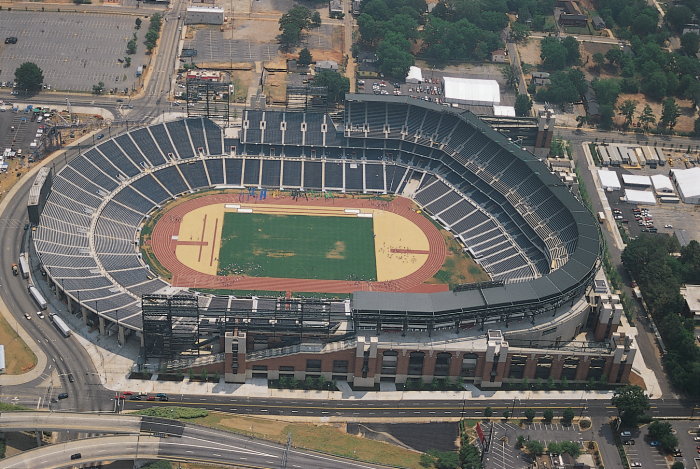



1996 年の夏、何百万人もの観客がアトランタを訪れ、世界最高のアスリートたちが金メダルを目指して競い合うのを見守りました。観客は、陸上競技、マウンテン バイク、ボート、サッカーなどの激しいスポーツで、高度なスキルを持つ男女が競い合う様子を見守りました。コンディション調整と気象条件への適応能力が、各競技で誰が一番優れているかを決めました。しかし、観客は環境や悪天候がアスリートに及ぼす危険に気づかないこともありました。そして、1996 年の夏季オリンピックは、一年で最も暑い時期に開催されました。
これらの大会の成功を確実にするために、商務省海洋大気庁の一部門である国立気象局 (NWS) が、アトランタ オリンピック委員会 (ACOG) や選手、観客、メディアに気象サポートを提供しました。気象状況は、一連の最新機器を使用して監視されました。最新の衛星とドップラー レーダーに加えて、監視ステーションのネットワークが、ジョージア州にある 2 つの NWS オリンピック気象サポート オフィスに現在の地表状況を報告しました。この高密度の監視ネットワークのバックボーンは、ジョージア大学の自動環境監視ネットワーク (AEMN) を構成する Campbell Scientific CR10 ベースの気象ステーションによって形成されました。AEMN は、高解像度の数値モデルをサポートするために必要なデータを生成するために、NWS がデータのないエリアに設置した追加のステーションによって補完されました。
AEMN は、ジョージア大学農業環境科学部によって 1991 年に設立されました。AEMN の主な目的は、農業研究現場で詳細な気象データを収集することです。物理、化学、生物学の研究にデータを提供するだけでなく、詳細な気象情報は最新のコンピューター化された農業シミュレーション モデルや意思決定支援システムに入力されます。
AEMN は 4 つの CR10 ベースのステーションから始まり、現在は 31 のステーションで構成されています。各ステーションにはモデムと専用電話回線でアクセスします。グリフィンのパーソナル コンピューターは、少なくとも 1 日に 1 回各ステーションに電話をかけ、前日のデータをダウンロードします。ダウンロード後、データはアプリケーションとアーカイブ用に処理されます。
取得した気象データは、多くの団体にとって貴重で重要なリソースとなっています。毎日の概要レポートは、地元の新聞社、テレビ局、公共事業会社、さまざまな農業企業に自動的にファックスで送信されます。月次概要レポートは、農業およびその他の産業のさまざまなクライアントに配布されます。3 つのステーションには、現在の気象状況を音声で報告する VS1 音声合成電話モデムがあります。
アトランタ大会を支援する NWS にとっての AEMN の価値は、1991 年にはすでに認識されていました。当時、ACOG は NWS に、馬術競技会場の候補地 6 か所で気象データを収集するよう要請しました。ジョージア州の夏の高温多湿の条件のため、代替地が検討されていました。1991 年 7 月から 8 月にかけて、AEMN が運用する CR10 データロガーは、詳細な温度、相対湿度、風速、風向のデータを記録しました。この情報は ACOG に提供され、最終的にコンヤーズのジョージア国際馬術公園が会場として選ばれました。
その後の NWS からの要請に応えて、ジョージア大学はオリンピックをサポートするために 8 つの気象観測所を追加購入し設置しました。これらのユニットは、コニャーズのジョージア国際馬術公園 (馬術、近代五種競技、マウンテンバイク レース)、ゲインズビルのレイニア湖 (カヤックスプリント、ボート、カヌー)、テネシー州のオコイー川 (カヌーおよびカヤックスラローム)、サバンナ近郊のワッソー湾のウィリアムソン島 (ヨット)、ジョーンズボロのアトランタ ビーチ (ビーチバレー) でデータを記録しました。残りの観測所は、追加の気候情報が必要な重要な場所に設置されました。
NWS には多数のオフィスがあり、大会期間中に気象情報を提供する自動地表観測システム (ASOS) も設置されています。ASOS および AEMN ステーションが利用可能であったにもかかわらず、ネットワークにはギャップが残っていました。この問題を解決するために、NWS は 1995 年に CR10 ベースの気象ステーション 14 台を追加購入しました。ステーションは、ウルフ クリーク (射撃)、クラーク アトランタ大学 (フィールド ホッケー)、ジョージア工科大学 (水泳、ダイビング、水球)、ストーン マウンテン パーク (テニス、アーチェリー、トラック サイクリング) などの会場に設置されました。残りのステーションは、ジョージア州とアラバマ州の気候が厳しい地域に設置されました。さらに、新しいオリンピック スタジアム内の気象状況を監視するために、2 つの臨時ステーションが車輪付きで設置されました。
CR10 ベースのすべてのステーションは、気温、相対湿度、風速、風向、降雨量を監視しました。AEMN ステーションは太陽放射と土壌温度も監視していたため、そのプログラムは、高度な NWS モデルのデータ要件に対応するように変更されました。すべてのセンサーは 1 秒間隔でスキャンされ、データは 15 分ごとに平均化されました。毎日の概要と極値は、真夜中に計算されました。
気象データを供給するその他のネットワークには、オーバーン大学が管理するアラバマ メソネット、ジョージア州林業委員会の火災気象観測所ネットワーク、テネシー州とカロライナ州にあるさまざまな自動化された観測所などがあります。
NWS は大会期間中、2 つの気象事務所を運営しました。1 つはピーチツリー シティ、もう 1 つはジョージア州サバンナ近郊です。両事務所とも、各観測所を 15 分間隔で調査しました。調査セッションは 1 回あたり約 60 秒かかるため、このタスクは複数のコンピューターで処理されました。次に、データは大量の入力データを処理する高解像度モデルに入力されました。モデルはスーパーコンピューターで 15 分ごとに実行され、各会場の天気予報を提供しました。その後、データは処理され、ACOG の情報システムを通じて会場管理担当者、競技役員、コーチ、選手に送信されました。
1996 年のオリンピック大会を支援するこの取り組みの成果として、膨大な量のデータが CD-ROM にアーカイブされます。これらのデータは、局所的な気候、空間的な気象変動、雷雨、海風、対流、その他の気象現象に関する研究に利用されます。気象データは、コミュニティへの気象サービスを改善する同様のネットワークを開発するよう他の組織を説得するきっかけにもなります。
ケーススタディの概要
アプリケーション
1996年ジョージア州アトランタ夏季オリンピックをサポートするため気象状況を監視場所
オリンピック会場、米国ジョージア州アトランタ使用製品
CR10寄稿者
Gerrit Hoogenboom, Department of biological/agricultural engineering, University of Georgia, Griffin, GA; Carlos Garza, Peachtree City Forecast Office, National Weather Service, NOAA, Peachtree, GA.参加団体
ジョージア大学国立気象局計測項目
気温、相対湿度、風速、風向、降水量、土壌放射、土壌温度関連ウェブサイト
The University of Georgia NetworkPDFで見る